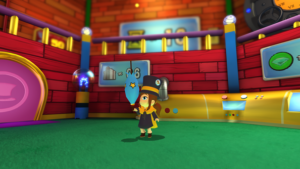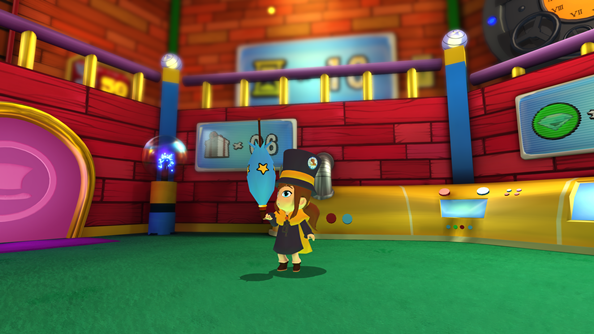Perfection amidst imperfection; savoring the flaws and comedically slapping itself in the face, all while adhering to a principled joy that overflows from the central protagonist. A Hat in Time, at length, is a game that embraces everything pointedly fun about childhood, puts into a game, and then delivers an experience brimming with purpose and fulfillment. The game is simultaneously a traditional 3D platformer while also smirking with a complete lack of care for tradition. Much like the protagonist, Hat Kid, A Hat in Time is not afraid to take risks by mocking the comfortable, and opting to embrace the often-humorous imagination that so many have left in the past.
However, those elements of A Hat in Time are only a part of the package that is wrapped with beautifully crisp and precise platforming. One can praise the game for its carefully crafted tone and adorable art, but the entire game is epitomized by gameplay and platforming that are endlessly fun, inviting, and never too boring. Combine ‘cute as heck’ artwork, platforming that is addictively inviting, and a game begging the player to explore every corner, Hat Kid takes her multitude of hats into the history books as A Hat in Time earns the 2017 game of the year.
(Note: There are spoilers herein, but the depth of the game ensures there is plenty to still uncover that is not covered in the remainder of the review.)
2017 Game of the Year: A Hat in Time – A Game for All Time
Refreshing Platforming in Precision
Jumping through imaginary worlds has never been so precise, fun, or more like cool water. No, A Hat in Time may not have the refined technical aspects, vast tradition, or engine capacity as other game of the year candidates like Mario Odyssey or Legend of Zelda Breath of the Wild – but just like cool water in the summer, A Hat in Time is inviting, always there for you, and refreshing as heck with the coolness of cheery, fun, and unique worlds.
What A Hat in Time does best is stick the true nature of its design. No game is complete without consistency in its intention, and if A Hat in Time does one thing exceptional, its consistently brings a fulfilling accomplishment in the platforming. Gears for Breakfast may not bring delivers intrinsic motivation to keep playing the game with the smirk of Hat Kid, the creativity in levels, and crisp platforming tied by refined levels.
Entrenched in exploration is a deep homage to the Nintendo 64 platformers of the past. Fortunately, the game mostly improves upon the mistakes of a foregone era by balancing the player with a multitude of challenges. In the first eight or so hours, time will be spent in a world filled with traditional platforming ques, solving mysteries in a ‘Tell your Tale’ spinoff off of Murder on the Orient Express, platforming with Meta Gear Series tactics, and getting chased on the roof top by Buddy Holly Owls.
Then there are the boss levels, which carry one of the major regrets of the game; they are so fun, the game needs more boss fights. All the cookie cutters were lost in production as each boss is unique and brings forth the unexpected. From a 2D fight akin to Kirby in Mafia Town, to jumping over knives and a sadistic Penguin later, the boss fights combine the design into the very nature of the gameplay. And those battles are difficult, which is a beautifully refreshing tactic the game uses. Each fight demands the player learn traits which the boss attacks with. If the player lets their attention slip for one moment, the game will mock them with something totally unexpected.
Maybe that is the beauty of A Hat in Time – everything is comforting and leaves the player grinning while being simultaneously shocked by the unexpected. From the time rifts – levels with pure platforming – vast worlds, or the boss fights, the fundamental nature of the game’s design is a bundle of childlike fun.
The Unexpected Becoming the Expected, which is Totally Unexpected
A Hat in Time is reminiscent of a younger, almost child like art design. Hat Kid herself is the very personification of a younger sister; one moment she will be blowing kisses, the next she will be mocking the daftness of Mafia Town or dominating the parody of Hollywood by defeating verbose (and again, surprisingly sadistic) penguins.
Sure, there is charm and humor in the delight of the ‘younger sister nature’ of Hat Kid. But, at the same time, she is a poignant and dominating spirit of her own desire. The game has an overwhelming tone of power to the player within imagination. Underneath the layers of pure gameplay are mocking tones of the less copious factors of mankind. The humor of Mafia Town or Battle of the Birds is found within the very discomfort it unsettles by mocking real-world institutions.
Then, the game has a dark side – Subcon forest is shocking with its haunting design, often very dark in nature. Finding characters who cry, “We want to die!” delivers a laughably dark moment and irony amidst the dank and cloud ridden Subcon Forest. Hat Kid has to literally fight for her soul while later running from a tortured and lost soul in a dark manor.
The entire game’s art and tone are over the top, crazy, and completely adorable and loveable. Those factors make A Hat in Time a game for all time. The entire adventure is complete with art that does not attempt to be a power house of graphics, and even in those instances which it cannot live up to the technical aspects of more formidable studios of the time, the game makes up for by breaking the proverbial fourth wall.
The voice acting adds another layer to the package – warm and colorful characters throughout come to life with talented voice acting, so much so, the voice lines are pleasant to listen to. (See Snatcher, voiced by Luke Sizemore, as a great example). Despite there being no story, or cohesive theme for that matter, Hat Kid’s interactions are so unexpected, the game’s tone is to make the unexpected the expected, filling every nook and cranny with purpose.
And that epitomizes the whole adventure. There is no corner, voice line, music piece, or thematic element left without purpose. Even if the game lacks for overt technical pop, the endless smile and fulfilling purpose Gears for Breakfast brought forth makes everyone whom plays A Hat in Time forget to nitpick for complaints.
A Collection with Purpose
Turning back to the gameplay itself, a good 3D platformer would not be complete without a collection catalog that begs the player to see 100% crawl across the screen. Whereas so many games intertwine collection elements wholly bereft of purpose, A Hat in Time’s collection quests are brimming with purpose. Every item, whether for humor or to assist in gameplay, has precise intent.
Naturally, there are three items intrinsic to supporting the regular flow of the game for those who are not collect-a-thon types. The plethora of hats will give Hat Kid unique abilities to gain access to hidden areas, items, or powerups. Badges are used to grant more powerups such as hook shoot or even alleviate the ever annoying “boking on walls” that occurs in platformers. Time Pieces are of course the entire purpose of the game, and must be collected to repower Hat Kid’s ship.
After those items, there are those which are not important to completing the game, but add to the adventure. And with the precise and welcoming platforming, they are all rewarding to collect. Hence, joy in the process of discovery, an often-forgotten element of gaming.
Relics add stands throughout the ship for humorous diatribes on some of humanities less austere qualities. Rift tokens are tokens for the gambling addict. Storybooks are in the Timerifts, completing poignant picture tales purely for the amusement of the player. Then there are the cosmetics, so intricately designed the player is left wanting to find more to see what the developers have created next. Hats and gorgeous, rushing music remixes can be collected and then implemented throughout the adventure to add a mix to the already precious base game.
Most importantly, while not all of the collectable items play a role in the game’s base goal, each item has a purpose that invites the player to live in Hat Kid’s Universe.
Hat Kid’s Universe – We’re All Living in It
Hat Kid’s Universe is perfectly imperfect. If all the joys of childhood platforming, color with the wise cracking themes of mature humor and mockery, and Lego-esque imagination could be wrapped up in a bubble, it would be Hat Kid’s Universe. The charm of every corner; the charm of every collectable item; the charm of the smile within the platforming makes A Hat in Time the 2017 game of the year. The purpose to leave a smile on everyone’s face was succinctly accomplished, leaving the player with 15 or more hours of content buried in adorable… everything.
The best of gaming in 2017 was Hat Kid’s Universe, and everyone is just wishing to possess her pointedly joyous smirk – a reminder of the simple joy of enjoying an imaginative and bright life in the vastly imperfect year of 2017.
Main Image Credit: Gears for Breakfast Press Kit


